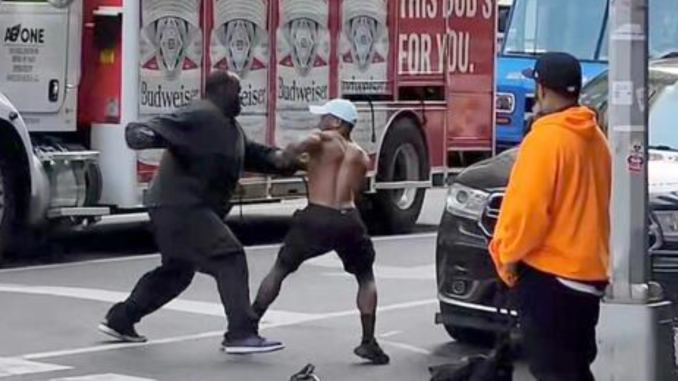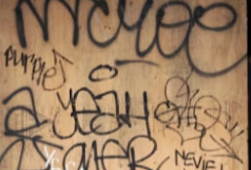
New Yorkers witnessed a surreal sight last week, an alien scene that made residents question the city’s future livability.
No, not wildfire smoke that turned the sky orange but a slow-motion murder unfolding in a Manhattan crosswalk as rush-hour passersby went about their day.
Is this the apocalyptic new normal?
Just after 8 a.m. at Seventh Avenue and 30th Street, in the commuting corridor from Penn Station to Chelsea tech offices, two 30-something men punch each other.
As traffic stops, they move into the crosswalk.
One pulls a small knife.
The two stand a foot or so apart, sparing with each other as if this were an MMA fight in the middle of the avenue.
A woman dressed in neat professional clothes — black skirt just above the knee, pale-blue summer jacket, gray curled coif, perfectly adjusted K95 mask — cuts through the scene as she crosses the street, close enough to one of the combatants to nearly brush him.
The fight is in full view, but she keeps her head down and, like Lot’s wife, offers only a furtive glance back at the two men as she quickens her pace.
As one of the men brandishes his knife at his opponent, another pedestrian in business-casual office wear — baby-blue shirt, dark jacket — also hurries by, head resolutely down.
A man in an orange sweatshirt idly watches from the sidewalk.
A woman in medical scrubs — and medical mask — crosses the avenue right between the two fighters.
She stops, apparently to tell them to knock it off. But when they don’t, she, too, keeps on moving.
Seconds later, one of the two men is dead, bleeding out in the crosswalk.
The other, Nisean Graves, 34, whom police say provoked the fight, is charged with murder.
The first thing to notice here is the bizarre contradiction in behavior on the part of both men.
Graves is, assuming our eyes and the police account do not deceive us, crazed enough to fatally stab someone in broad daylight, in full view of plenty of witnesses.
But he wasn’t crazed enough that he didn’t make sure to look out for traffic and even pause his attack to ensure the two women could safely cross.
As for the 36-year-old victim, who is still unidentified by police — but reportedly was wanted for a Baltimore murder of his own — it’s not at all to blame the deceased to observe he appeared to have had several chances to simply run away.
Instead, he chooses to stand and try to fight a man pointing a knife toward his torso.
If neither the alleged murderer nor his victim could de-escalate this situation, despite ample time, opportunity and motive, how could New York have prevented this murder?
The criminal-justice system failed: The alleged killer is barely a year off of a one-year prison sentence, incurred when he . . . repeatedly stabbed someone in Manhattan.
But New York’s supposed “eyes on the street” safety in crowds failed to prevent this murder, as well.
What about “bystander” de-escalation, so promoted by progressives?
The woman in medical scrubs does intervene. But when she fails, she understandably moves on.
Nobody else appears to try.
You can’t blame them. If you’ve lived anywhere near Midtown over the past three years, you’ve seen plenty of random street fights, whether shouting or punches, and your instinct is to get out of the way.
Intervening, or threatening to call 911, could get you hurt.
Or it could get you shamed as a “Karen” on a viral video for unleashing police violence on minority men involved in a minor dispute, which, in turn, could cost you your job.
And we are constantly told there is nothing to see: Progressives insist crime is low.
Never mind that Midtown South, the police precinct in which this murder occurred, has suffered 17 murders since 2020.
Before 2020, it took nine full years for Midtown South to record 17 murders.
This is the second broad-daylight murder in the area this year.
In February, alleged drug dealers shot and killed 22-year-old Idrissa Siby a few blocks to the north during the afternoon commute.
Major felony crime citywide through mid-May was nearing 20-year records, 42% above 2019 levels.
But we are reprimanded: We should not believe our eyes.
So some don’t — and walk on. Future crime victims, even when an arm’s touch away, are just invisible ghosts.
* Article From: The New York Post


